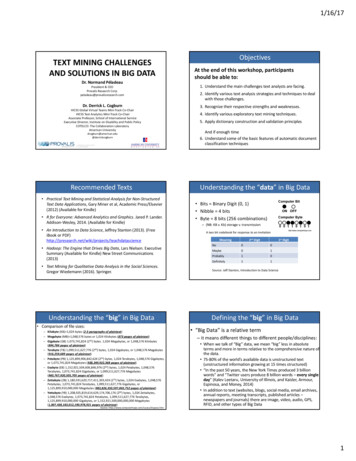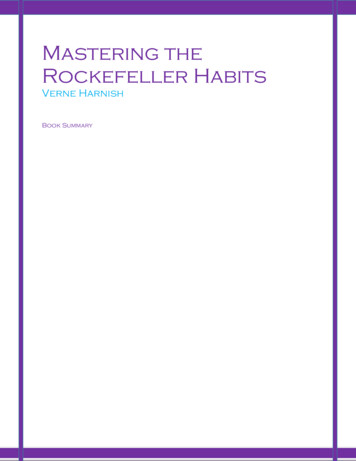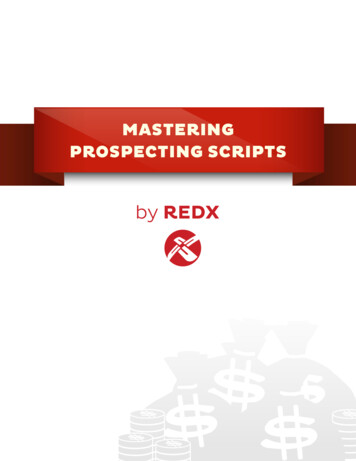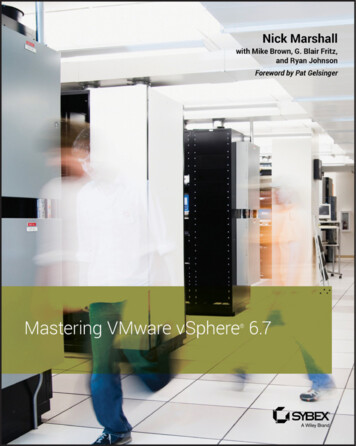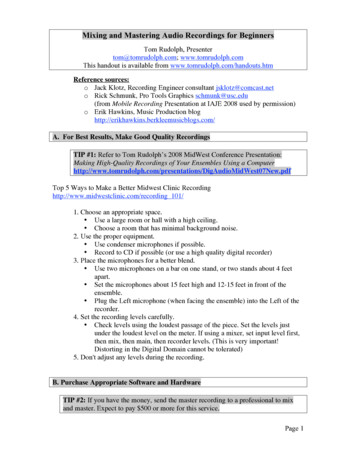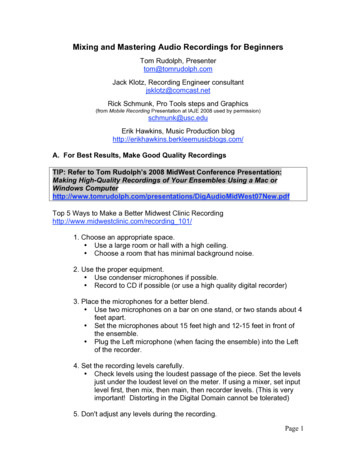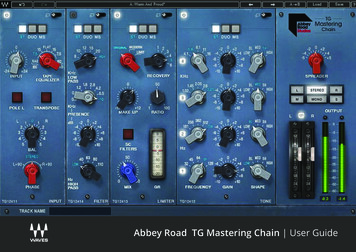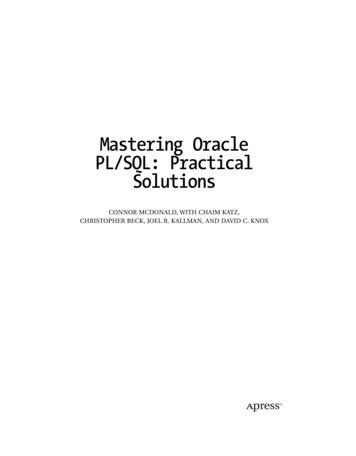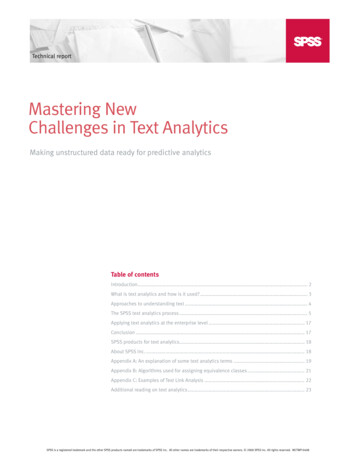
Transcription
Technical reportMastering NewChallenges in Text AnalyticsMaking unstructured data ready for predictive analyticsTable of contentsIntroduction. 2What is text analytics and how is it used?. 3Approaches to understanding text. 4The SPSS text analytics process. 5Applying text analytics at the enterprise level. 17Conclusion. 17SPSS products for text analytics. 18About SPSS Inc. 18Appendix A: An explanation of some text analytics terms. 19Appendix B: Algorithms used for assigning equivalence classes. 21Appendix C: Examples of Text Link Analysis. 22Additional reading on text analytics. 23SPSS is a registered trademark and the other SPSS products named are trademarks of SPSS Inc. All other names are trademarks of their respective owners. 2008 SPSS Inc. All rights reserved. MCTWP-0408
IntroductionIt’s no secret that the world has seen an explosion of information in the past 15 years, an explosion that experts predictwill continue as the millions of people who use online resources continue to expand their usage, and the millions of peoplewho do not yet have access to such resources gain it. Similarly, information stored as text in both business and governmentorganizations has grown exponentially.To name just a few examples:nOpinion surveys are increasingly conducted online and results shared in real timenThe boom in software applications supporting sales, customer service, or call center operations has led to massiveamounts of text stored electronically in these applications’ notes fieldsnTechnology analysts at IDC estimate that 62 billion e-mails are sent every daynSearchable Web sites generate enough information every day to fill millions of booksnWeb logs (blogs) and wikis, created by individuals and groups for personal and professional purposes are increasingexponentially: as of this writing, there may be more than 100 million blogs, with a new one created every secondSuch a vast expansion of the scale of global information exchange would have been almost unimaginable 40 years ago,when most business and government communications, as well as news reports and advertising, were paper-based.Yet it was 40 years ago that visionary researchers began to seek ways to enrich the knowledge of those working in medicineand other sciences, in government agencies, and in business by making it possible to uncover previously unknown connectionsin large collections of textual documents by using computer technologies. They created the discipline known as computationallinguistics, which is now practiced at numerous universities and public and private research centers worldwide.Computational linguists initially focused their efforts on finding ways to categorize and explore concepts found in books,scholarly journals, legal briefs, patent applications, newspapers, reports, and other paper-based records that could beconverted to digital formats. More recently, their efforts have expanded to include ways to “mine” the vast amount of textualinformation that is published digitally—online editions of newspapers, academic journals, and conference proceeding, forexample. In addition, there is a wealth of content that originates in digital form—such as Web sites, blogs, wikis, e-mails,instant messaging (IM), as well as text embedded in forms, surveys, and in scientific, government, or corporate databases.There is a growing recognition that analyzing text has become essential in various types of scientific research, and that it addssignificant value to other forms of data analysis, particularly when used to predict how people may act in certain situations.For example, in obtaining a well–rounded view of customer behavior, text analytics is critical because it provides insight intothe nuances of attitudes and opinions that influence behavior. With the exponential growth of text in online formats, waysmust be found to structure this information and make it available to researchers and decision makers.This paper briefly defines text analytics, describes various approaches to text analytics, and then focuses on the naturallanguage processing techniques used by SPSS Inc.’s text analytics solutions. It concludes with descriptions of SPSS solutionsfor text analytics and their role in predictive analytics.2Mastering New Challenges in Text Analytics
What is text analytics and how is it used?First, it may be helpful to clarify what we mean by the terms text analytics and predictive analytics.To clear up one misconception, text analytics is not the same as search. Search engines are a “top down” approach tofinding information in textual material. This means that end users must know how to structure queries to arrive at exactlythe desired information. Text analytics, by contrast, is a “bottom up” approach. It does not require users to know particularsearch terms. Instead, text analytics reveals the concepts and themes contained in a body of documents, and then mapsthe relationships between them.To provide a more formal definition: Text analytics is a method for extracting usable knowledge from unstructured textdata through identification of core concepts, sentiments, and trends, and then using this knowledge to support decisionmaking. A “document” might be a scholarly journal article, free text responses to a market research survey, records froma database—such as call center notes or customer e-mails—contents of a news feed, or even a crime scene report.Text analytics discovers connections and relationships not within a single document but across a large collection or“corpus” of documents. These connections and relationships can then be organized in ways that permit analysis eitheralone or in combination with other types of data. Practitioners of text analytics may use algorithms to describe clustersof concepts, or associations between certain concepts or named entities. Text analytics results can then be incorporatedin models used for predictive analytics.Predictive analytics informs and directs decision making by applying a combination of advanced analytics and decisionoptimization to data, with the objective of improving business processes to meet specific organizational goals. Includingtextual or “unstructured” data along with the “structured” data found in databases or transaction records adds depthto the insights gained through data mining. Textual data often reveals attitudes and sentiments that, when combined withdemographic or behavioral data, enable analysts to more reliably predict events, behaviors, or actions that individualsor groups are likely to engage in.Text analytics has been shown to deliver measurable benefits to organizations in a wide range of applications. Forcommercial organizations, these include:nSupporting improved customer relationship management (CRM) by providing a more well-rounded view of customers,their wishes and preferences, leading to more effective marketing, reduced churn, and improved customer loyalty andlifetime valuenCatching the “voice of the customer” through surveys or data from Web 2.0 interactions to improve customer loyaltyand brand monitoringnAccelerating cycle times in the development and refinement of products, and early detection of product issues throughwarranty analysisnAchieving a clearer view of the competitive landscapeText analytics also has applications in the public sector; for instance in:nUncovering patterns that suggest fraudulent behavior may be occurringnDetecting connections among groups of criminalsnIdentifying possible security threats or illegal activityMastering New Challenges in Text Analytics3
In addition, text analytics can be invaluable in scientific and medical research; for example by:nSpeeding the exploration of secondary research materials, such as patent reports and journal articlesnIdentifying previously unknown associations among people, research projects, or productsnMinimizing the time spent in the drug discovery processThese are just some examples of how text analytics is being used, and how it can enhance predictive analytics. Moreapplications are being implemented every day. Organizations simply cannot afford to ignore this wealth of textual information.Approaches to understanding textThere are several approaches that an organization might take when performing text analytics. In the past, the tradeoff hasbeen between accuracy and speed; between the cost of human labor and the cost of computer technologies. Today,organizations are reaping the benefits of increased accuracy and reduced cost in applying computer technologies to textanalytics; but there will always be a need to incorporate human knowledge into the process.One approach to understanding text is simply having people read the documents, note their contents, and determine intowhich categories they should be placed. Market researchers, for example, often categorize or “code” free-text responsesin surveys. Because people are good at understanding text, this approach is quite accurate; but it is time-consuming andexpensive. In addition, a manual approach cannot offer guidance in identifying relationships or trends in the informationanalyzed. With the immense volume of text now available, often in multiple languages, other approaches are needed.A second approach is to employ automated solutions based on statistics. Some of these, however, simply count the numberof times terms occur and calculate their proximity to related terms. Because they cannot factor in the ambiguities in humanlanguages, relevant relationships may be hidden in masses of irrelevant findings—or missed altogether. Some of thesestatistics-based solutions compensate by providing ways for analysts to create rule books that help suppress irrelevantresults. But these rulebooks need to be created and continually updated by analysts, which adds cost and complexity.Other statistics-based solutions rely on self-learning tools such as Bayesian networks, neural networks, support vectormachines (SVM), and/or latent semantic analysis (LSA). While these solutions can be more effective than other statisticalapproaches, they have the drawback of being “black boxes”—that is, using hidden mechanisms that cannot be adjustedexcept by highly skilled statisticians or programmers.Linguistics-based text analytics offers the speed and cost effectiveness of statistics-based systems, but it offers a far higherdegree of accuracy. Linguistics-based text analytics is based on the field of study known as natural language processing(NLP). (For a glossary of selected text analytics terms, see Appendix A.) The understanding of language that is possible withthe NLP approach cuts through the ambiguity of text, making linguistics-based text analytics the most accurate possibleapproach.Initially, linguistics-based solutions may require some human intervention—in developing dictionaries for a particularindustry or field of study, for example. But the benefit obtained from these efforts is significant: results are more accurateand the techniques involved are more transparent, meaning that they can be modified by users to further increase theaccuracy of results.4Mastering New Challenges in Text Analytics
The SPSS text analytics processLike data mining, text analytics is an iterative process, and is most effective when it follows a proven methodology. Thismaximizes analyst productivity, supports comparability of results, allows findings from one analysis to be used to inform orguide others, and facilitates data-driven decision making.In data mining, the industry-standard methodology—used by thousands of organizations worldwide—is the CRoss-IndustryStandard Practice for Data Mining (CRISP-DM). This same methodology supports text analytics.This paper describes the linguistic processes involved in text analytics, which follow the broad outlines of the CRISP-DMmethodology in that once data is understood, prepared, and modeled, the resulting models are evaluated—whether theyinvolve only text analytics results or are combined with other types of data. Finally, results are deployed, either as reports or asscores driving automated systems such as recommendation engines. As with data mining, the two main steps in text analyticsare data preparation and data understanding.The next sections describe how analysts would use SPSS’ text analytics products to engage in text analytics.There are seven major steps in the text analytics process:1. Preparing text for analysis2. Extracting concepts3. Uncovering opinions, relationships, facts, and events through Text Link Analysis4. Building categories5. Building text analytics models6. Merging text analytics models with other data models7. Deploying results to predictive modelsBecause this paper focuses on the linguistic capabilities built into SPSS’ text analytics products, it will cover the first foursteps in this process, with some discussion of deployment to predictive models.WorkflowPrepare textfor analysisExtract conceptsApply TextLink AnalysisBuild categoriesDeploy to predictivemodelsWorkflowThe workflowis similar, whetherExtractthe conceptsgoal is to analyze journalinternal documents,Web pages, verbatimresponsesPrepare textApplyarticles,TextDeploy to predictiveBuildBuild categoriescategoriecategoriessfor analysisLink Analysismodelsto surveys, call center notes, or other sources of text data.WorkflowPreparePreprepare texttextforfor analysisanalysisanalyExtract conceptsApply TextLink AnalysisBuildBuild categoriescatecateggorieoriessDeploy to predictivemodelsApply TextLink AnalysisBuildBuild categoriescatecateggorieoriessDeploy to predictivemodelsWorkflowMasteringin Text AnalyticsPreparePreprepNeware texttexChallengestforfor analysisanalyanalysissisExtract concepts5
WorkflowPrepare textfor analysisExtract conceptsApply TextLink AnalysisBuild categoriesDeploy to predictivemodelsExtract conceptsApply TextLink AnalysisBuildBuild categoriescategoriecategoriessDeploy to predictivemodelsWorkflowPrepare textfor analysisWorkflowPreparing text for analysisIn orderPPreparetopareconducttext analytics,a body of documents, or Apply“corpus,”is needed. A BBuildcorpuscan range from aDeploysmallsample torepretexttextTextto predictiveExtract conceptsuild categoriescatecateggorieoriessforfor analysisanalysisanalyLink Analysismodelstens of millions of documents. The documents may be written in multiple languages and represent a variety of file types:HTML, PDF, ASCII, e-mail, and common Microsoft Office formats.WorkflowSPSS text analytics solutions can process text in all these formats. In addition, they can process survey text saved in SPSS’ format, as well as text from RSS feeds (including blogs and news feeds), databases, and other ODBCDimensionsPreparePreprepare texttextApply TextDeploy to predictiveforfor analysisanalyanalysissiscompliantsources.Extract conceptsLink AnalysisBuildBuild categoriescatecateggorieoriessmodelsSPSS text analytics solutions use powerful, linguistics-based capabilities to prepare text documents for analysis. The threeWorkflowsteps in the preparation of documents are:nLanguage identificationnforfor PreparePrepare texttextExtract conceptsApply TextLink AnalysisBuild categoriesDeploy to predictivemodelsWorkflow these steps take place “behind the scenes,” it is valuable to understand what occurs during this phase of the textAlthoughanalytics process.PreparePrepare texttextforfor analysisanalysisanaExtract conceptsApply TextLink AnalysisBuild categoriescategoriecategoriessBuildDeploy to predictivemodelsLanguage identificationFor corpora that use multiple languages, language identification is the first step in the extraction process. (For singlelanguage corpora, this step is not necessary.)The SPSS text analytics extractor can recognize more than 80 languages in different formats, based on patterns knownas “n-grams” that are specific to each language. About 400 n-grams are used to identify each language. Below is a subsetof tri-grams used for recognizing French (some are combinations of letters, others are combinations of letters and spaces):“ le,” “omm,” “ à,” “mma,” “le ,” “du ,” “nt ,” “ma ,” “ et,” “té ,” “ dé,” “les,” “ur ,” “ux ,” “une,” “ ré,” “iod,” “pou,”“rp,” “ui ,” “ait,” “rpa,” “pré,” “ ce,” “ité,” “ire,” “ée ”, “com,” “par,” “ef ,” “od ,” “au ,” “iqu,” “ref,” “ ét,” “oit,” “lpa,”“our,” “tio,” “air,” “eur,” “ du,” “és” “.av,” “ns ,” “tai”SPSS text analytics solutions are available for seven native language extractors: English, French, Spanish, Dutch, German,Italian, and Portuguese. (SPSS text analytics products also support the extraction of Japanese concepts; Japanese extractionuses a different process not described in this document.)6Mastering New Challenges in Text Analytics
Additionally, through the use of Language Weaver software, the English language extractor supports translations fromthe following 14 languages: Arabic, Chinese, Dutch, French, German, Hindi, Italian, Persian, Portuguese, Romanian,Russian, Somali, Spanish, Swedish. Language Weaver continues to add new translation capabilities, which SPSS productswill continue to support.Document conversionOnce the language has been identified, the SPSS text analytics solution converts documents to a format that can be usedfor further analysis. Using built-in filters, the software converts common file types to a plain text format. Text fromdatabases and other ODBC-compliant sources can also be converted. For example, in an XML-based document, the tagscan be used to specify the text that is to be extracted, including page titles, metadata, and document tags, if desired.The text analytics solution also removes non-textual elements such as graphic files, which are unusable for text analytics.SegmentationAfter the documents are converted to plain text, the text analytics solution segments the text into individual elements fromwhich concepts will be extracted. SPSS text analytics software identifies markers for the ends of sentences, paragraphs,and documents. It also removes certain special characters or character sequences or replaces them with spaces.During this step, the software automatically corrects or prepares text so that it’s optimal for mining. For example, theWorkflow identifies character strings from the input text, based on delimiters. Delimiters include spaces, tabs, carriagesoftwarereturns, and punctuation marks. In SPSS text analytics technologies, any word that contains a punctuation mark that isPrepare textApplyText process, be treated as part of a term. ForDeployto predictivenot precededor followed by a space,will, in the next stepsof theexample:Extract conceptsBuild categoriesfor analysisLink AnalysismodelsnU.S.nxalpha(s) proteinnx.k-atpaseWorkflowbeta-m subunitPreparetextTextto predictiveSPSS textanalyticssolutions canalso accommodate poor Applypunctuationin the text,BBuildsuchas improper use ofDeployperiods,Extract conceptsuild categoriescategoriecategoriessfor analysisLink Analysismodelscomma
The SPSS text analytics process Like data mining, text analytics is an iterative process, and is most effective when it follows a proven methodology. This maximizes analyst productivity, supports comparability of results, allows findings from one analysis to be used to inform or g
